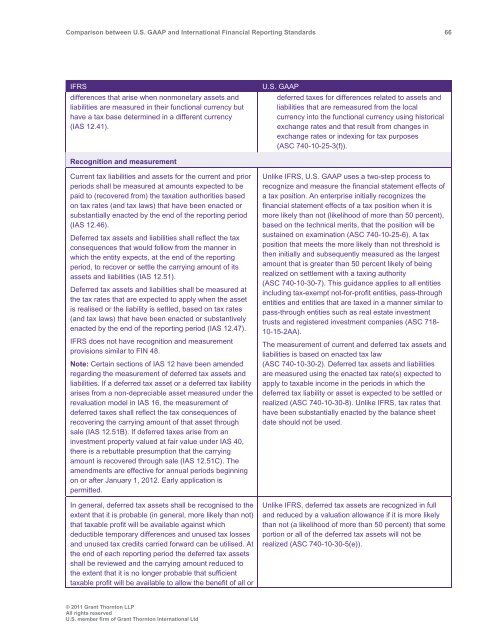Comparison between U.S. GAAP and International ... - Grant Thornton
Comparison between U.S. GAAP and International ... - Grant Thornton
Comparison between U.S. GAAP and International ... - Grant Thornton
Create successful ePaper yourself
Turn your PDF publications into a flip-book with our unique Google optimized e-Paper software.
<strong>Comparison</strong> <strong>between</strong> U.S. <strong>GAAP</strong> <strong>and</strong> <strong>International</strong> Financial Reporting St<strong>and</strong>ards 66<br />
IFRS<br />
differences that arise when nonmonetary assets <strong>and</strong><br />
liabilities are measured in their functional currency but<br />
have a tax base determined in a different currency<br />
(IAS 12.41).<br />
U.S. <strong>GAAP</strong><br />
deferred taxes for differences related to assets <strong>and</strong><br />
liabilities that are remeasured from the local<br />
currency into the functional currency using historical<br />
exchange rates <strong>and</strong> that result from changes in<br />
exchange rates or indexing for tax purposes<br />
(ASC 740-10-25-3(f)).<br />
Recognition <strong>and</strong> measurement<br />
Current tax liabilities <strong>and</strong> assets for the current <strong>and</strong> prior<br />
periods shall be measured at amounts expected to be<br />
paid to (recovered from) the taxation authorities based<br />
on tax rates (<strong>and</strong> tax laws) that have been enacted or<br />
substantially enacted by the end of the reporting period<br />
(IAS 12.46).<br />
Deferred tax assets <strong>and</strong> liabilities shall reflect the tax<br />
consequences that would follow from the manner in<br />
which the entity expects, at the end of the reporting<br />
period, to recover or settle the carrying amount of its<br />
assets <strong>and</strong> liabilities (IAS 12.51).<br />
Deferred tax assets <strong>and</strong> liabilities shall be measured at<br />
the tax rates that are expected to apply when the asset<br />
is realised or the liability is settled, based on tax rates<br />
(<strong>and</strong> tax laws) that have been enacted or substantively<br />
enacted by the end of the reporting period (IAS 12.47).<br />
IFRS does not have recognition <strong>and</strong> measurement<br />
provisions similar to FIN 48.<br />
Note: Certain sections of IAS 12 have been amended<br />
regarding the measurement of deferred tax assets <strong>and</strong><br />
liabilities. If a deferred tax asset or a deferred tax liability<br />
arises from a non-depreciable asset measured under the<br />
revaluation model in IAS 16, the measurement of<br />
deferred taxes shall reflect the tax consequences of<br />
recovering the carrying amount of that asset through<br />
sale (IAS 12.51B). If deferred taxes arise from an<br />
investment property valued at fair value under IAS 40,<br />
there is a rebuttable presumption that the carrying<br />
amount is recovered through sale (IAS 12.51C). The<br />
amendments are effective for annual periods beginning<br />
on or after January 1, 2012. Early application is<br />
permitted.<br />
In general, deferred tax assets shall be recognised to the<br />
extent that it is probable (in general, more likely than not)<br />
that taxable profit will be available against which<br />
deductible temporary differences <strong>and</strong> unused tax losses<br />
<strong>and</strong> unused tax credits carried forward can be utilised. At<br />
the end of each reporting period the deferred tax assets<br />
shall be reviewed <strong>and</strong> the carrying amount reduced to<br />
the extent that it is no longer probable that sufficient<br />
taxable profit will be available to allow the benefit of all or<br />
Unlike IFRS, U.S. <strong>GAAP</strong> uses a two-step process to<br />
recognize <strong>and</strong> measure the financial statement effects of<br />
a tax position. An enterprise initially recognizes the<br />
financial statement effects of a tax position when it is<br />
more likely than not (likelihood of more than 50 percent),<br />
based on the technical merits, that the position will be<br />
sustained on examination (ASC 740-10-25-6). A tax<br />
position that meets the more likely than not threshold is<br />
then initially <strong>and</strong> subsequently measured as the largest<br />
amount that is greater than 50 percent likely of being<br />
realized on settlement with a taxing authority<br />
(ASC 740-10-30-7). This guidance applies to all entities<br />
including tax-exempt not-for-profit entities, pass-through<br />
entities <strong>and</strong> entities that are taxed in a manner similar to<br />
pass-through entities such as real estate investment<br />
trusts <strong>and</strong> registered investment companies (ASC 718-<br />
10-15-2AA).<br />
The measurement of current <strong>and</strong> deferred tax assets <strong>and</strong><br />
liabilities is based on enacted tax law<br />
(ASC 740-10-30-2). Deferred tax assets <strong>and</strong> liabilities<br />
are measured using the enacted tax rate(s) expected to<br />
apply to taxable income in the periods in which the<br />
deferred tax liability or asset is expected to be settled or<br />
realized (ASC 740-10-30-8). Unlike IFRS, tax rates that<br />
have been substantially enacted by the balance sheet<br />
date should not be used.<br />
Unlike IFRS, deferred tax assets are recognized in full<br />
<strong>and</strong> reduced by a valuation allowance if it is more likely<br />
than not (a likelihood of more than 50 percent) that some<br />
portion or all of the deferred tax assets will not be<br />
realized (ASC 740-10-30-5(e)).<br />
© 2011 <strong>Grant</strong> <strong>Thornton</strong> LLP<br />
All rights reserved<br />
U.S. member firm of <strong>Grant</strong> <strong>Thornton</strong> <strong>International</strong> Ltd
















